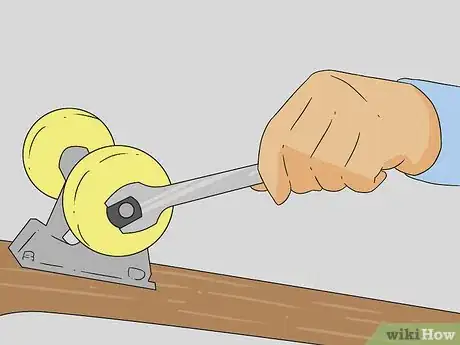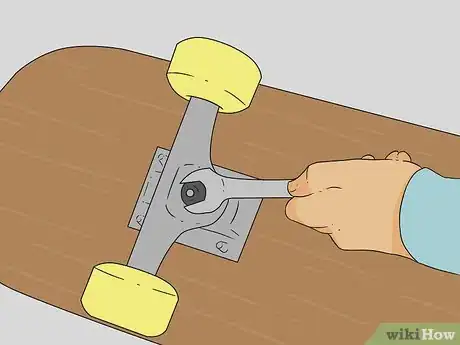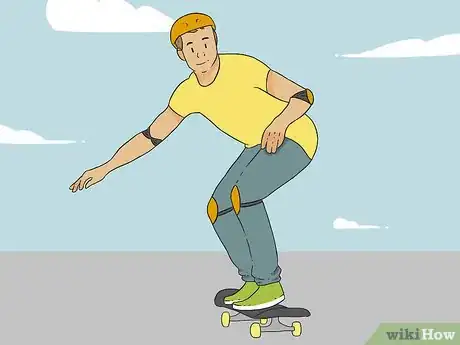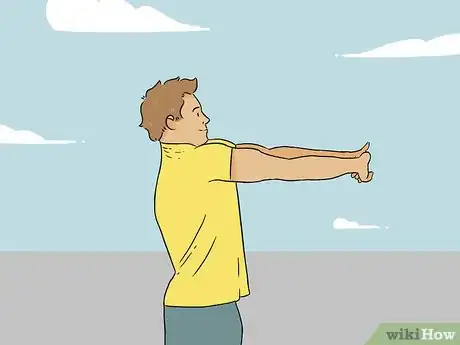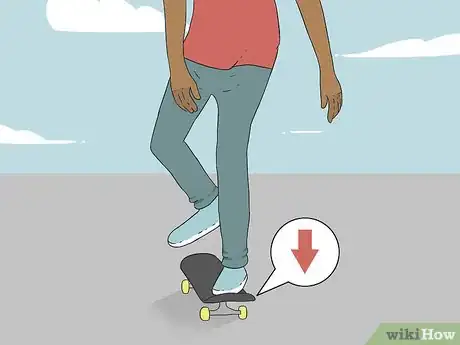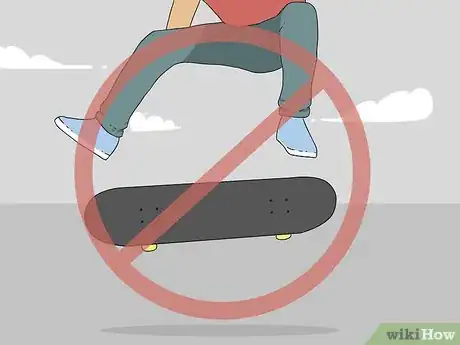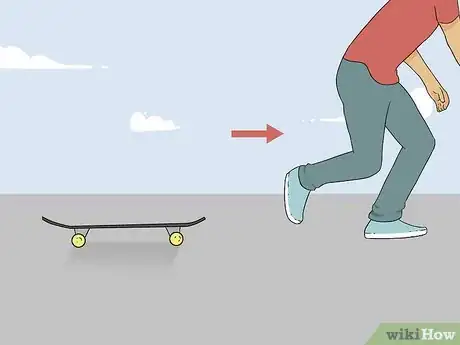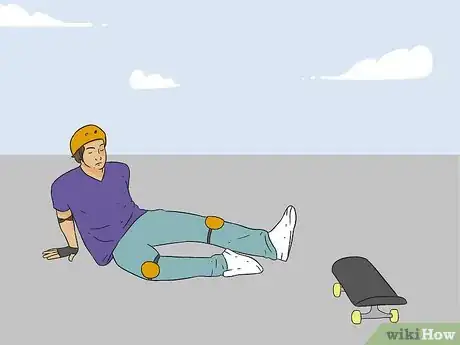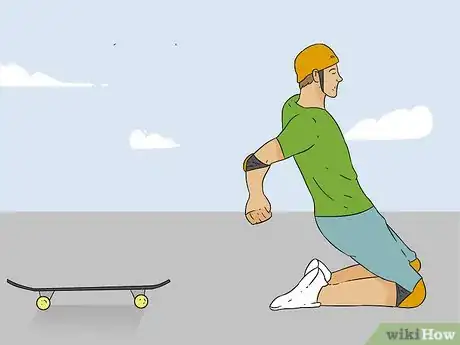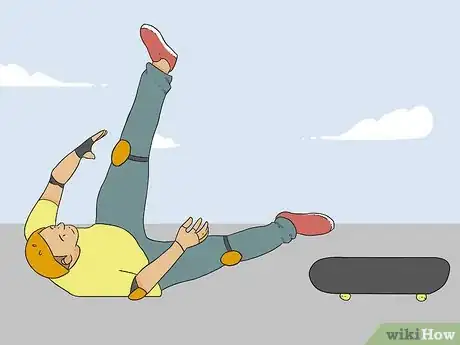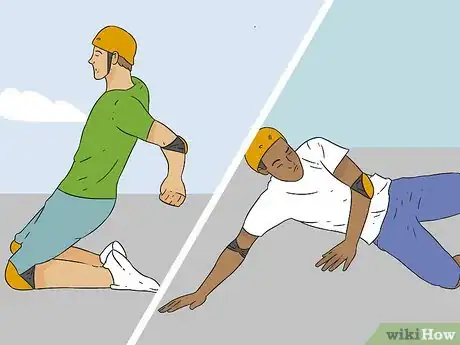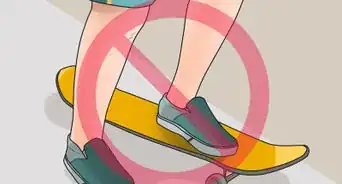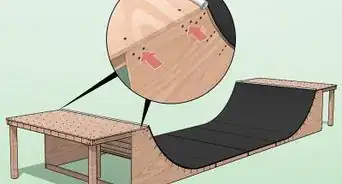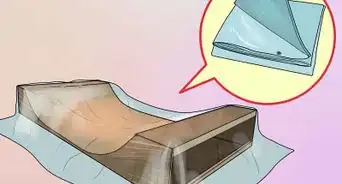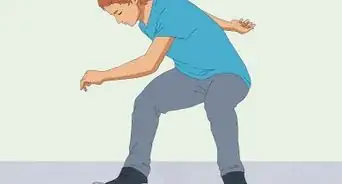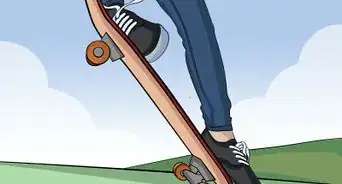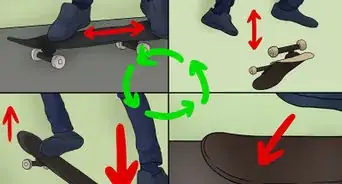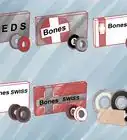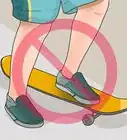This article was co-authored by Jon Depoian. Jon Depoian is a Skateboarding Instructor and the Owner of Intro2Skateboarding, an organization based in Orange County, California that provides professional private, home-school, after-school, birthday party, and summer camp skateboard lessons for beginners and experienced skateboarders alike. Jon has over 21 years of skateboarding experience and over 10 years of skateboard instruction experience. He also has extensive experience producing street skateboarding videos and skating competitions.
There are 7 references cited in this article, which can be found at the bottom of the page.
wikiHow marks an article as reader-approved once it receives enough positive feedback. In this case, 92% of readers who voted found the article helpful, earning it our reader-approved status.
This article has been viewed 110,941 times.
Skateboarding is a popular but sometimes risky sport. It's a great cardio workout and can be lots of fun, but a few falls and bruises are also part of the game. However, there are a few tips and tricks that can help you to avoid serious injury. Falling correctly can mean the difference between a serious injury, or a minor bruise. Skaters need to be as good at falling as they are at skating.
Steps
Checking Your Gear
-
1Safety check your board before riding it. Nuts and bolts should regularly be examined to ensure that they are not loose. It's important to check that the nuts that attach your wheels to the axle are securely fastened. These nuts should be tightened to the point where they can no longer turn (but not hinder the ability for wheels to move). You should tighten these bolts with a Phillips Head Screwdriver or a Socket Wrench.
-
2Adjust the trucks. These are the metal pieces that keep your wheels in place and they are secured by the kingpin bolt. Turn your board upside down, and adjust the nut in the middle of each truck counter clockwise with a half of a quarter turn to tighten it. The tighter your kingpin bolt, the more security you will have when skating. If you are a beginner, keep those trucks tightly bolted.
- If you are unsure about how to adjust your trucks by maneuvering the kingpin bolt, visit your local skate shop with your board, and ask them to show you.
Advertisement -
3Wear protective gear. Whether you're a professional skater or a novice to the sport, protective gear is essential if you want to skate safely. Wearing a helmet might not earn you cool points, but it will keep you safe and even protect you from getting a concussion if you fall and land on your head. It's best to protect all areas that are exposed, including your head, knees, and wrists.[1]
- Wrist pads, gloves, knee pads, and helmets are a good place to start if you want to purchase protective gear. They won't stop you from skids and falls, but they will protect exposed parts and prevent more serious injuries.
- Helmets should have a buckle strap and fit around your head snugly. Be sure to get a helmet that is specifically made for skateboarders.
Riding Safely
-
1Pick a safe place to ride. This is one of the most important decisions when it comes to skateboarding. It's best to skate on flat surfaces that are clear of rocks, ruts, and other debris. Make sure that there aren't any cars around that could knock you over.[2]
- Great places to skate safely include empty driveways or car parks, specialized skate parks, or empty pools that have not run into disarray. Remember to familiarize yourself with the different surfaces before you skate, and to always be on the look out for cars, other skateboarders, and people.
-
2Check weather conditions. Don't skate on wet or icy roads. You will be more likely to loose your balance and fall over.
-
3Warm up and stretch. Loosen up stiff muscles by doing some gentle stretches before you start skating. Rotate your neck and shoulders, roll out your ankles, and stretch your calves. After stretching, ride around on your board for a little while to get your muscles warmed up before doing any tricks. Warming up your body before exercising is an important way to prevent serious injury because it promotes blood flow to the muscles, and gradually builds up your heart rate. [3]
-
4Watch your speed. It's important that as a beginner skater you avoid traveling too fast, or skating down steep hills.
-
5Don't skate beyond your ability. If you are new to the sport, begin with mastering the basics. Once you feel more confident, you can take more risks. While skateboarding is about stepping outside of your comfort zone, you should always trust your gut. If a trick doesn't feel right, don't try it until you are ready. [4]
-
6Make sure your phone is charged. In the case of an emergency situation, it's important to be able to contact emergency services or people who can help you. Keep your phone battery fully charged, and make sure you have the number of your local ambulance service.
Trying out Bailing and Falling Techniques
-
1Run-out to avoid falls. You might be able to prevent a fall by getting off the skateboard and running. Jump off your board by placing your back foot onto the ground in front of the skateboard, and following with your front foot. Begin running in the direction that you were traveling in and only stop the board once you have slowed down and regained control.[5]
- Practice your running technique from a stationary skateboard first. Once you have got the hang of this, try running from a moving board, in a quiet space. Only try this at the skate park after lots of practice.
-
2Bail out when you need to. Bailing is when you opt out of a trick before you get hurt. If you know that you're about to fall hard, you can try and stop the trick before it's too late, and jump off your board. Rather a bruised ego, than a bruised leg![6]
- It is important to kick your board away when bailing, as you don't want to land back on your board and slip over. If you kick forward there is a greater chance that you will land back on the board, so always kick the board behind you by kicking your legs back.
- Bailing isn't good for your board deck, and it will cause scratches and chips. However, it is better to bail and chip your board, than to not bail and hurt yourself.
-
3Fall correctly. If a fall is inevitable, you need to use all your limbs to soften the impact. It is important to keep your arms and legs loose so that they can absorb the shock of the fall. [7]
- If you stiffen your body, there is a greater chance of you breaking bones. Keep those limbs loose!
- Don't break falls by using only your outstretched arms. Wrist injuries are rife in skateboarders, and this is going to hurt or cause you to break your wrists.
-
4Break falls with your knees if you are skating on a ramp. It's a good idea to wear knee-pads and if you are going to fall whilst on a ramp, always fall on your knees. This will cause you to slide down the ramp, and avoid serious injury.[8]
-
5Roll after a fall. Rolling distributes the impact of a fall and prevents serious injury. Remember to shield your face with your arms and aim to land on your back or shoulders.[9]
-
6Keep practicing your falls. Practice falling correctly on a soft surface before you hit the skate park. This way you'll be prepared for future falls and falling safely will become second nature to you. [10]
Expert Q&A
Did you know you can get expert answers for this article?
Unlock expert answers by supporting wikiHow
-
QuestionHow can skateboard injuries be prevented?
 Jon DepoianJon Depoian is a Skateboarding Instructor and the Owner of Intro2Skateboarding, an organization based in Orange County, California that provides professional private, home-school, after-school, birthday party, and summer camp skateboard lessons for beginners and experienced skateboarders alike. Jon has over 21 years of skateboarding experience and over 10 years of skateboard instruction experience. He also has extensive experience producing street skateboarding videos and skating competitions.
Jon DepoianJon Depoian is a Skateboarding Instructor and the Owner of Intro2Skateboarding, an organization based in Orange County, California that provides professional private, home-school, after-school, birthday party, and summer camp skateboard lessons for beginners and experienced skateboarders alike. Jon has over 21 years of skateboarding experience and over 10 years of skateboard instruction experience. He also has extensive experience producing street skateboarding videos and skating competitions.
Skateboarding Instructor Wear a helmet, elbow pads, and knee pads whenever you ride. If you're just starting out, start by skating on smooth surfaces that won't have any rocks or obstacles, like a tennis court. Get used to balancing on the board and turning safely before you head out to the skatepark or try to ride any ramps.
Wear a helmet, elbow pads, and knee pads whenever you ride. If you're just starting out, start by skating on smooth surfaces that won't have any rocks or obstacles, like a tennis court. Get used to balancing on the board and turning safely before you head out to the skatepark or try to ride any ramps. -
QuestionWhat company do you recommend for protective gear?
 Community AnswerElement makes pretty good protective gear that is also very durable.
Community AnswerElement makes pretty good protective gear that is also very durable. -
QuestionCan a beginner do ollies without injury?
 GieldeboerCommunity AnswerYou can, just make sure you know how to break the slams.
GieldeboerCommunity AnswerYou can, just make sure you know how to break the slams.
Warnings
- Try to avoid hitting joints as often as possible.⧼thumbs_response⧽
- When you fall, the three most important places to avoid getting hit are your head, spine, and knees.⧼thumbs_response⧽
- Wear appropriate padding and protection. Helmets are strongly recommended for everyone.⧼thumbs_response⧽
References
- ↑ Jon Depoian. Skateboarding Instructor. Expert Interview. 5 June 2020.
- ↑ Jon Depoian. Skateboarding Instructor. Expert Interview. 5 June 2020.
- ↑ https://www.redbull.com/in-en/basic-stretching-before-shredding-the-skate-park
- ↑ http://www.skateboardtricksforbeginners.com/8-skatepark-tips-for-beginner-skateboarders
- ↑ Jon Depoian. Skateboarding Instructor. Expert Interview. 5 June 2020.
- ↑ http://www.skateboardhere.com/skateboard-fall.html
- ↑ http://www.skateboardhere.com/skateboard-fall.html
- ↑ Jon Depoian. Skateboarding Instructor. Expert Interview. 5 June 2020.
- ↑ https://www.thoughtco.com/how-do-i-fall-safely-skateboarding-3002441
